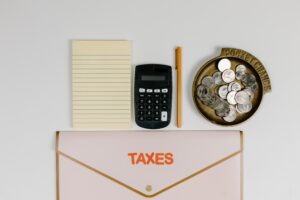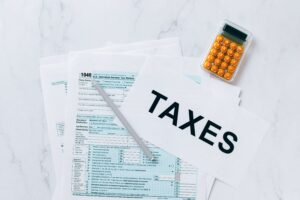There are a surprising amount of ways that you can be investing but not need to pay any tax on your gains and/or proceeds. As an accountant, it is super common to have people ask this but I always say to talk to a specialist in tax to avoid any legal issues arising.
Tax-free investing can occur through the use of an ISA, by trading below your Capital Gains Tax Allowance (CGTA), earning below your Personal Allowance (PSA), earning below your Dividend Allowance (DA) and Personal Savings Allowance (PSA) .
It’s also worth considering exactly what you are investing in – investing in the stock market and investing in gold may have different tax allowances. Here’s an brief overview of the type of tax shelters and the investments they’re best suited to:
| Investment Type ↓ | ISA | CGTA | PA | DA | PSA |
|---|---|---|---|---|---|
| Stocks & Shares | ✔
(Stocks & Shares ISA) | ✔
(If trading outside an ISA) | ✔
(If DA is fully used up) | ✔
(For first £2,000 of dividend income) | ✘ |
| Personal Savings | ✔
(Using a Cash ISA) | ✘ | ✔
(If earning below £12,000 a year) | ✘ | ✔
(Up to £5,000 in interest) |
| Commodities | ✘ | ✔ | ✘ | ✘ | ✘ |
In this article, we will dive DEEP into utilising ISAs, Capital Gains Tax Allowance, Personal Allowance, Dividend Allowance and Personal Savings Allowances so you know exactly how much you can invest without paying a penny of tax.
What do you want to invest in?
Depending on the type of investments you’re looking to buy into – there are a wide range of options available to you. Some investment options could include:
- Stocks & Shares;
- Savings Accounts; and
- Commodities (like Gold).
An honourable mention here would be Cryptocurrencies. However, as it is so volatile and brand new – I feel advice here would be out-dated very quickly so may not be worth mentioning for the time being. Additionally, property is a big one so I’ll address this in a separate post.
As we go through each of the tax-free investing ‘vehicles’ i.e. ISAs, I’ll point out which are the best suited for each kind of investment.

Individual Savings Accounts (ISAs)
In the UK, there are 4 ISAs you can put your money into. They’re all completely tax-free but they’re used for completely different purposes.
Just to preface this – at the time of writing, there is a £20,000 allowance on these accounts. This means that you can only add £20,000 into an ISA every tax year. This is split over all of the ISAs you have – you can’t contribute £20,000 to each of them unfortunately.
Without further ado, let’s take a look at why you’d want to open them up (other than their tax-free goodness).
Different types of ISA
Cash ISA
Cash ISA’s are essentially just a static savings account that you put your money into. Like with other savings accounts – you get a rate of interest but the cool thing is that you’ll get that interest into your account WITHOUT THEM TAKING TAX OFF OF IT!
How do you invest in a Cash ISA?
You can literally just ask the bank you have your bank account with and see what they have on offer. Most established banks will be able to offer these very quickly and there isn’t a mountain of paperwork to be done first.
Key considerations
If you’ve googled ‘how to invest without paying tax’ and reading this article – odds are you’re looking at investing a lot of money with a view to get some big returns.
If that’s the case – you’re limited to £20,000 a year in contributions and the interest rate of Cash ISA’s are abysmally low. For example, my Cash ISA (had it opened up years ago) gives me 0.05% interest….
Stocks & Shares ISA
Next up, we have our ‘Stocks & Shares ISA’. This is the one I am currently using as I don’t earn enough to break the £20,000 annual contribution limit.
In the UK, when we buy and sell shares from a regular bank account – all gains made on shares are classed as ‘Capital Gains’ and are taxed at 20% and their dividends are taxed at 7.5%. These rates grow by quite a bit if you’re a higher rate or additional rate tax payer already!
The beautiful thing about the Stocks & Shares ISA is that any gains and dividends you make from investments within your Stocks & Shares ISA is completely tax-free! HAPPY DAYS!
How do you invest in a Stocks & Shares ISA?
Similar to the Cash ISA – it’s something you can either contact your bank about or open online. However, they are still an ISA and therefore subject to the £20,000 limit.
There is a way that we can navigate around investing more and still not needing to pay any tax but we’ll come onto that a bit later.
Key considerations
This is my personal recommendation as I don’t have £20,000 to save each year and I don’t want anything I DO manage to make, being taxed.
If you’re not comfortable with setting up a Stocks & Shares ISA or you simply prefer investing using a normal trading account – this is also fine. Just be wary that you’re liable for the tax.

Lifetime ISA
Lifetime ISAs (or LISAs) are ISAs which can either be used to put towards a first-time home or a pension. This option, although it offers tax-free money – it’s not the best choice for those looking to actively invest.
LISAs will appeal mainly to first-time buyers. Although you can only contribute £4,000 a year to this specific ISA, the government gives you 25% of your annual investment (i.e. £1,000 if you invest £4,000) each year completely tax free!
Unfortunately, there is a 25% charge if you try to take it out before the age of 60 so you can’t just pocket their cash and leg it.
How do you invest in a Lifetime ISA?
As with the rest of the ISAs, you can just set this up in your local bank branch or do it online. Just make sure you are fully aware of the different rules and limits on the account so you don’t invest then find out you’ll lose money when you want to withdraw it.
Innovative Finance ISA
IFISAs are all about peer-to-peer lending and tend to give you better returns than a standard Cash ISA.
The premise of this is to open up a new channel of funding to consumers, businesses and property – however this does come with a risk of default and it’s not backed by FSCS as it’s peer to peer investing.
Based on this – I’m not going to cover this in the article as it’s not something I’d be comfortable with recommending at this point in time.

Capital Gains Tax Allowance
In the UK, in 2020/21 – the CGTA is currently at £12,300. This means that any gains you make during the year, up to the value of £12,300 – you don’t need to pay any tax on at all.
Going back to our table at the start of the article, you can see that utilising this allowance is best for Stocks & Shares investments as well as commodities. Let’s take a look at why.
Stocks & Shares
We’ve pretty much covered this in our ISA section – you can essentially keep your investments nicely tucked under the cover of your ISA to avoid the taxman knocking at your door. However, if you’re flush with cash or you’re a big-time earner, the £20,000 contribution limit per year is really going to stifle your investing.
This is when we need to educate ourselves with the Capital Gains Tax Allowance (CGTA). When you open yourself up a regular trading account and invest money in your first lot of shares – any gains you make are actually taxable… and to rub dirt in the wound, the dividends you earn are taxable too (but we’ll talk about this with the Dividends Allowance).
So the first thing I would do is fully utilise your £20,000 ISA allowance. The remainder can then be put into your regular account. Following some good performance, you’ll want to sell up your shares and take your taxable gains… but wait – we have a safety net of £12,300 that is our glorious CGTA.
In essence, you can make unlimited gains in your ISA without needing to pay tax but also realise £12,300 in gains from a normal trading account too!
It’s super important to note that you DON’T have to declare gains on shares that you still hold. Just the shares you have sold and ‘realised’ the gain on. You can stay invested for an extra year and liquidate £12,300 more as your CGTA resets each tax year.
Commodities
Like with Stocks & Shares, there are platforms you can invest into commodities such as Gold or Silver. However, they’re usually paired against a different commodity and the movement of the investment grows or falls as the value of one commodity moves in relation to another investment.
An example would be investing in Gold:Silver – this means you’ve put money into Gold and will generate gains if the value of Gold increases in relation to Silver. If they both go up, your investment won’t move much.
The REAL way to invest in these commodities is to simply purchase the raw material itself. You can buy bullion or sovereign coins and hold them as an investment. This is probably the ‘safest’ way to invest as you actually have a tangible investment that you can keep locked away – rather than numbers on a screen.
When you sell these commodities for a profit, they fall within the scope of Capital Gains Tax (CGT) and so any gains need to be taxed at 20% – unless the gain doesn’t surpass the £12,300 allowance.
It’s worth noting that investments in certain gold coins are actually exempt for CGT and therefore you don’t need to worry about working out the gains for tax purposes!
Personal Allowance
In the UK, for 2020/21 – the personal allowance is £12,570. This means that whatever income you earn, the first £12,570 is completely tax-free.
When we’re looking at using this to make investments tax-free, the key thing to look at is how much you’re taking home from your job. Unfortunately, well… probably not unfortunately – most people are more than £12,570 a year so any additional income you earn, is taxed.
HOWEVER – income earned from investments are actually covered by a few different allowances. Income received as dividends are covered under a Dividend Allowance and income received as bank interest is covered under a Personal Savings Allowance.
Essentially, unless you’re receiving some sort of other income – not having any Personal Allowance isn’t the end of the world.
Now, if you’re earning crazy money – there may be an issue here. For every £2 you earn above £100,000, you lose £1 of your Personal Allowance. Therefore, if you’re earning over £125,140 ((2 x £12,570 ) + £100,000), you don’t get the Personal Allowance!

Dividend Allowance
This is very rarely used up by people as not many people are avid investors. However, this £2,000 allowance allows you to receive dividend income from your investments, up to the value of £2,000 without needing to pay any tax on it!
If we take a look at our table at the top of the article. The Dividend Allowance only really applies to the investments in shares and stocks (basically the investments that provide dividends).
I know we’re looking to keep the investment returns as tax-free as possible but at a Basic Rate of 7.5%, dividend income is the lowest rate of tax you’ll have to pay on income received.
Personal Savings Allowance
Finally, probably the least known allowance available – the Personal Savings Allowance. This is only available to people with income less than £17,570.
This may look like a bit of a weird looking figure but the allowance is £5,000 but reduces by £1 for every £1 you earn that is over the £12,570 Personal Allowance. So by the time you’re earning £17,570, you’ll have lost all of your Savings Allowance.
This allowance only relates to bank interest received on savings – however, if you’re a hotshot investor looking for some ways to invest tax-free, you’re probably earning more than that and this won’t be much use.
